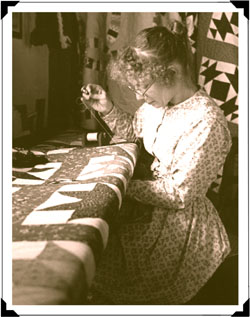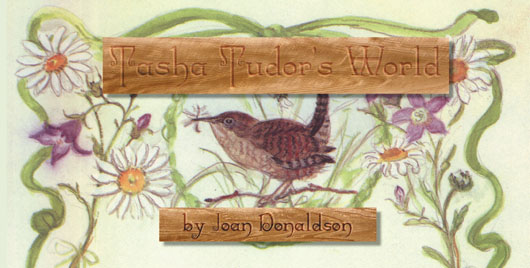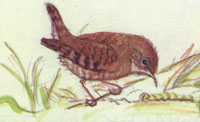|
Tasha Tudor's World
By Joan Donaldson
Printed in Practical Homeschooling #5, 1994.
 Learn about the "real world" Tasha Tudor illustrated
Learn about the "real world" Tasha Tudor illustrated

|

"You homeschoolers are just sheltering your children from reality! They will never learn to get along in the real world!" Red-faced neighbors. Worried grandmas. Concerned friends. They all believe in a "real world" that children can only become part of by doing exactly what all the other children their age are doing. Watching the popular TV shows (like Beavis and Butt-head?). Wearing the popular clothes ("If you don't wear Nike, you're nothing!") Talking the popular language ("Don't bug me, you &#%$^!") Learning politically correct doctrines at the government school.
While these concerned people accept the fashions, entertainments, and mass-produced values of Hollywood and Madison Avenue as the "real world," homeschooling families are discovering we can create our own worlds. We can not only control what enters our home; we can create beauty within our home that you can't find in today's "real world."
 One resolute woman who has cultivated a world of her own is author/illustrator Tasha Tudor. With over 75 books to her credit,Tasha has delighted millions of children with her drawings depicting youngsters in activities from a century ago. Many readers may remember the Tasha Tudor Fairy Tale Book or her illustrations for such classics as The Little Princess or The Secret Garden. Tasha is perhaps best known for the elaborate, whimsical borders with which she frames many of her paintings. You can see two examples on the pages of this article!
One resolute woman who has cultivated a world of her own is author/illustrator Tasha Tudor. With over 75 books to her credit,Tasha has delighted millions of children with her drawings depicting youngsters in activities from a century ago. Many readers may remember the Tasha Tudor Fairy Tale Book or her illustrations for such classics as The Little Princess or The Secret Garden. Tasha is perhaps best known for the elaborate, whimsical borders with which she frames many of her paintings. You can see two examples on the pages of this article!
Tasha's art is a world of beauty and whimsy. So is her life. As a close friend and a frequent visitor I usually feel as if I have crossed the boundaries of time when I enter Tasha's dimly lit barn and race down the hallway that attaches the out-buildings to her cottage. You see, Tasha has chosen to live in the nineteenth century! Like the Amish, she shuns most of the modern "real world." Unlike the Amish, she has done so on her own for over half a century.
When Tasha's children were young, her family made their own entertainment by reading aloud for hours from classical literature. Tasha took her youngsters on afternoon walks to the river. While the children waded she would sketch them frolicking. Without television or other electronic amusements Tasha's homeschooled brood developed skills in carpentry, writing, and sewing. Together they combined their talents to construct marionettes, write scripts, and build scenery. The shows were most of the time based on the books the family read and were performed at the next party.
Each season in Tasha Tudor's world offered reasons to celebrate. Sometimes it was a sugaring-off party to taste the sweetness of early spring or a bonfire to light the sky in honor of Epiphany. But the children's most cherished memories emanate from when they welcomed the first day of summer. Arriving in old-fashioned clothes the guests contributed to the sumptuous potluck laid out on tables roped with daisy chains. Soon young and old filled the carriage shed to enjoy the long awaited marionette performance. Finally came traditional music and country dancing as couples chained across the wide boards of the bar floor reveling in the lingering twilight of the longest day of the year.
Tasha sought to give her offspring a gentle, joyful childhood. And today Tasha paints these innocent scenes into her books, giving audiences a glimpse of what life can be for those with the courage to walk down poet Robert Frost's "road less traveled."
Tasha still lives this way today. Instead of a recreation center, the Tudor home boasts a weaving room. She still uses the sturdy four-harness loom on which she made cloth for her family's clothing. Did the children feel deprived? No! Once son Seth so loved a linen shirt that he refused to relinquish it to the wash! In their old-fashioned clothes the children posed for their mother, sometimes neatly at the tea table, but more often barefoot in the garden. As Tasha captured these moments in her artwork, she affirmed that it is possible to turn back the clock and nurture a family founded on simplicity and celebrating life.
 Inspired by Tasha's art and friendship, my own family has sought to create a lifestyle consistent with our values of simple living and a conscience based on Phillipians 4:8. Focusing on what is pure and lovely, we've excluded television, radio, and other forms of mass consumer media. From the moment we picked up our sons from their South American orphanage we have placed good books in their hands. As a family we have shared special moments reading together books such as My Side Of The Mountain. Sharing Sam Gribley's desire to live off the land, my boys can be found catching fish with their hands and searching the meadows for useful herbs. While my husband reads to me I busy my hands with quilting, producing the covers that the boys snuggle under once story time is over.
Inspired by Tasha's art and friendship, my own family has sought to create a lifestyle consistent with our values of simple living and a conscience based on Phillipians 4:8. Focusing on what is pure and lovely, we've excluded television, radio, and other forms of mass consumer media. From the moment we picked up our sons from their South American orphanage we have placed good books in their hands. As a family we have shared special moments reading together books such as My Side Of The Mountain. Sharing Sam Gribley's desire to live off the land, my boys can be found catching fish with their hands and searching the meadows for useful herbs. While my husband reads to me I busy my hands with quilting, producing the covers that the boys snuggle under once story time is over.
Like Laura and Mary of the Little House books, my boys will fondly remember the nights they fell asleep listening to their parents make music. As traditional musicians, we play many of the jigs and reels that Pa did. Often we gather with friends to share tunes. Our love of music must be rubbing off on our sons. Rarely do they grumble about practicing their piano playing; they are used to seeing adults play for pleasure.
Likewise our boys join in our enthusiasm for gardening. While snowflakes fly we surround ourselves with seed catalogs. Each child is encouraged to choose something special for his garden. This has lead to Carlos' prize winning pumpkins, and Mattie's bags of homegrown popcorn given as Christmas presents. The hours spent in the garden allow for plenty of time for parent-child discussions and the opportunity to observe insects and birds. We've even had baby bluebirds land on our shoulders while weeding!
We are not trying to cut off our children from modern society; we are trying to give them something better. Is it any wonder therefore that my children's friends all want to play at Pleasant Hill Farm? Some come for the gabled playhouse with its child-size door and window boxes overflowing with geraniums. Youngsters enjoy climbing to the loft and gazing out over pastures and fields. Most playmates run to our pond to splash after minnows. Like a scene from one of Tasha's paintings, the children paddle our row boat, their laughter skimming across the water.
My fondest memories involve our post-and-beam barn built into the side of Pleasant Hill. Friends love to recall the June day they arrived one hundred strong to lift the massive timbers into place with ropes and poles. We have had the joy of experiencing a "real world" satisfaction few know today. And nothing can be more "real" than our sturdy barn!
Recently friends and family have gathered to perform plays in the barn, sing hymns, and feast on the tantalizing potlucks spread out on wide pine boards resting on saw horses. We have also hosted treasure hunts; our boys especially like to remember the time one set of clues was stuffed in bottles attached to bobbers and sunk in the pond.
True, we are blessed with a creative community that rejoices in combining their talents to fashion homespun memories for their children. But this community only developed because someone -- Tasha -- was strong enough to recognize the "real world" of Hollywood and Madison Avenue wasn't the only world.
Our joyful moments with our friends have been nurtured by the idea that, with the help of Christ and the guidance of His commandments, collectively we can give our offspring an innocent childhood free of worldly violence and pressures. Together we share the vision that by abandoning the mass consumer culture which attempts to control how we think, dress, and play we can create a new and joyful world for our children. Watching the stars in our children's eyes, we look forward in hope that someday our world will be the "real world" all families can experience.